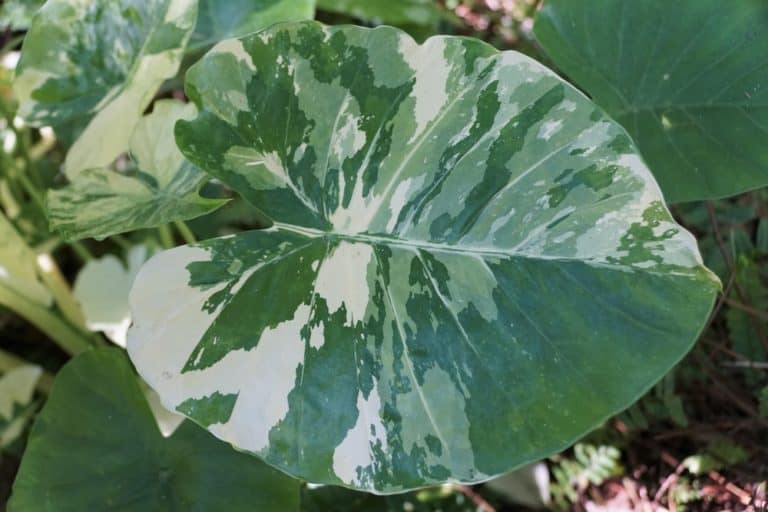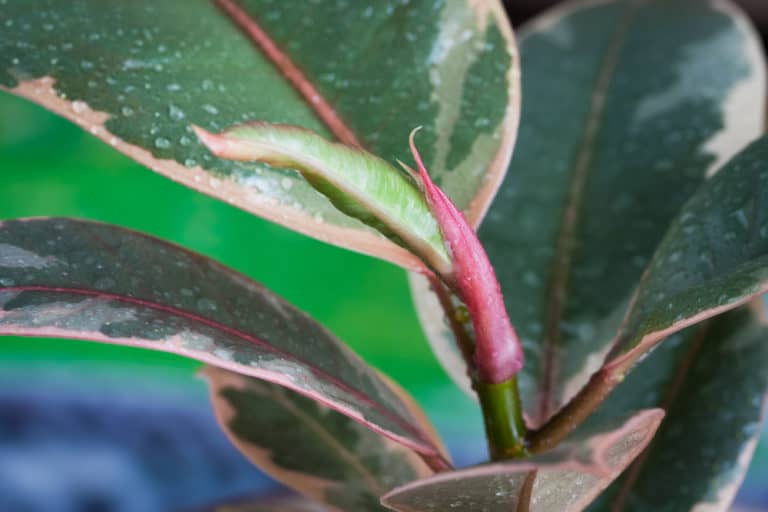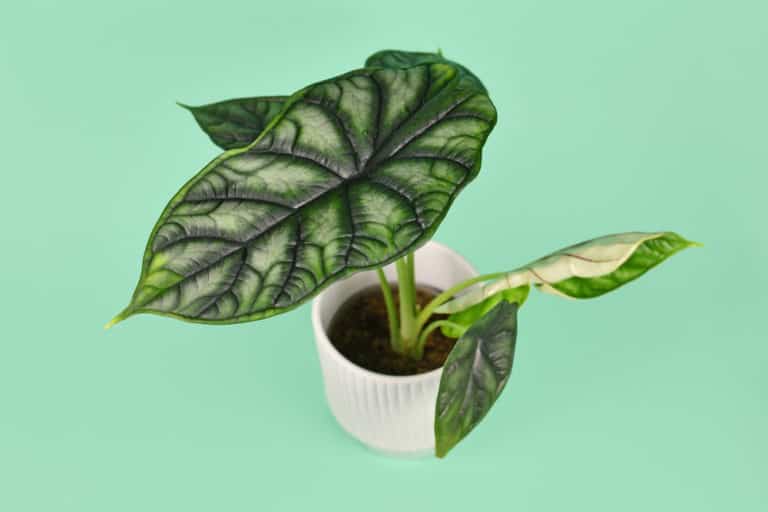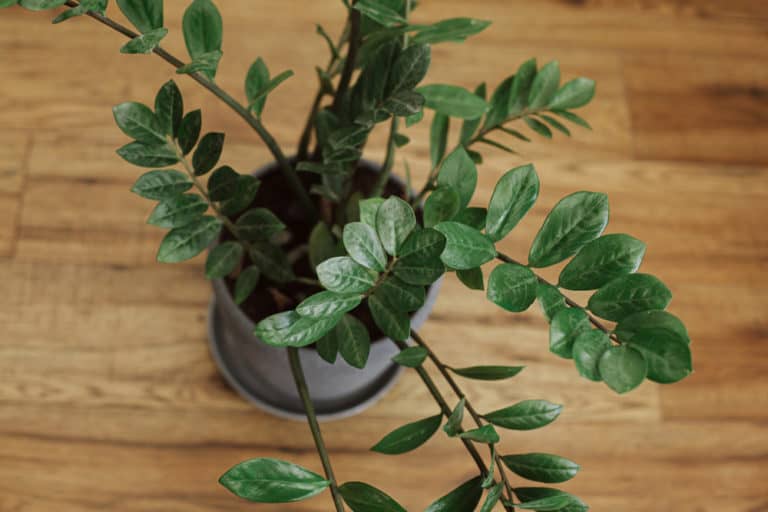Alocasia Macrorrhiza ‘Giant Taro’ Care Guide (2024)
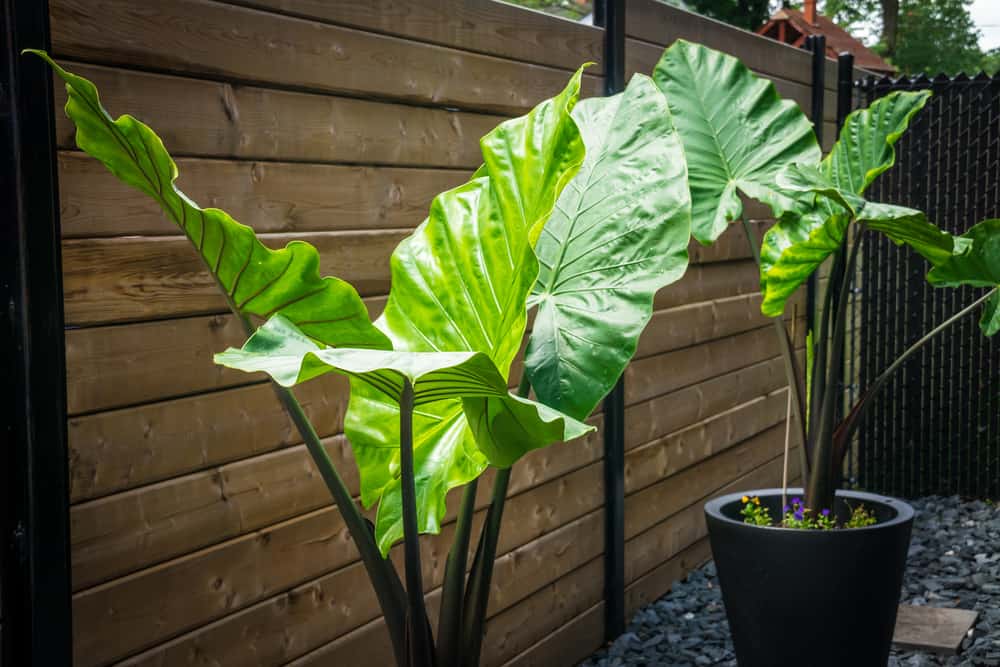
The best thing about Alocasia macrorrhiza is that it has extravagant leaves that resemble the shape of elephant ears. They are stunning for their huge appearance that will create a beautiful display both indoors and outdoors. Also known as Giant Taro, this species also comes in variegated versions. Plus, they’re relatively easy to grow.
| Scientific Name | Alocasia macrorrhiza |
| Common Name | Giant taro, giant alocasia, giant elephant’s ear |
| Light | Semi-Shade, Full Sun |
| Watering | Lots of Water, soak-and-dry method |
| Temperature | 55° and 85°F (13 to 29°C) |
| Hardiness Zone | USDA hardiness zones 9b to 12 |
| Humidity | 60% or above |
| Soil Type | Combination of soil, peat moss, perlite |
| Soil pH | Acid to Neutral |
| Fertilizing | Add balanced liquid fertilizer in the growing months |
| Repotting | Repot every two years |
| Pruning | Remove the plant debris and the dying leaves |
| Propagation | Seed, Stem Cuttings (only for mature specimens) or Basal Offset Division |
| Toxicity | Toxic to dogs, cats, and horses |
| Mature Size | 12-15 inches tall in optimum growing conditions with a spread to 6-10 inches wide |
| Bloom Time | Late spring or early summer |
What’s Unique About Alocasia macrorrhiza?
Alocasia macrorrhiza plant is both an ornamental and a food crop. The foliage is a major attraction with its large size and glossy touch. Hence, many gardeners love adding this plant to achieve a tropical vibe. On the other hand, the corm of each alocasia taro is also edible. Many locals consume them as a vegetable or even as snacks like taro chips and fries.
This species is native to Malesia (including Peninsular Malaysia, the Philippines, and parts of Indonesia), Queensland, and the Solomon Islands. A member of the Araceae family, it’s an herbaceous plant that has a perennial growth cycle.
Alocasia macrorrhiza Care
The techniques for proper Alocasia macrorrhiza plant care will depend on whether it is planted indoors or outdoors. Nevertheless, it’s important to remember three things. There must be a warm temperature, plenty of water, and bright light.
Remember that giant taro care is pretty simple and very much alike to other members of the Arum family.
Light
To achieve the correct Alocasia macrorrhiza light requirements, you have to first consider the natural environment in which this species lives. Giant alocasia is a dweller of the rainforest. Hence, it’s used to growing under the canopies of trees.
The giant taro light needs to be bright but indirect. You can expose it to full sun but only for about 2 hours each day. The morning sun will be best as the sunlight is not that intense. If placed indoors, choose a suitable location such as a window facing east, south, and north.
Low light conditions are not favorable for Alocasia macrorrhiza plants.
Watering
In some instances, Alocasia macrorrhiza tolerates standing water in its natural habitat. This plant is water-loving and would require 0.8 cups of water every 9 days if potted in 5.0 inches container.
It’s important to keep the soil moist but not soggy. Water giant Taro once the top inches of the soil surface gets dry. Avoid underwatering. You have to make sure that you meet the watering needs of your plant, especially during spring and summer.
You can adjust the Alocasia macrorrhiza watering frequency from once to twice a week depending on the condition and the prevailing season.
Temperature
Alocasia macrorrhiza temperature range falls perfectly between 55° and 85°F (13 to 29°C). As a tropical species, it thrives in areas with a warm environment. This species has no temperature tolerance below 50°F (10°C). If your plant is outdoors, you would have to bring it indoors once the temperature starts to drop.
Locations under USDA hardiness zones 9b to 12 provide a favorable climate for growing Alocasia macrorrhiza. It’s always better to find a suitable place where the temperature is not fluctuating. Avoid locations such as drafty windows, heaters, and air conditioners.
Once you provide the correct temperature for giant Taro, it will flourish perfectly.
Humidity
For better growth of your indoor Alocasia macrorrhiza, be mindful to provide the right humidity level. Giant taro loves high humidity, something that ranges between 50 to 60%. This isn’t difficult to achieve if the area you live in is tropical. However, there can be times when the environment can be dry, too.
In this case, there are certain techniques to attain your Alocasia macrorrhiza humidity requirements. You can mist around the leaves from time to time or turn a room humidifier on. It would also help to group your plant with other tropical species. Do these to help achieve the ideal humidity for giant Taro.
Soil
You can create the ideal Alocasia macrorrhiza soil by combining equal parts of regular potting soil, peat moss, and perlite. Such materials make an excellent combination to achieve a porous, well-aerated soil mix with proper drainage.
Remember that this species is a water-loving plant. Hence, the soil for giant Taro must have the right structure to drain excess water and retain just enough amount. This will help prevent the occurrence of root rot and other soil-borne diseases.
The ph level for giant Taro will have to be acidic and neutral (5.7 to 6.3). Check this using a pH meter.
Fertilizer
If you’re growing your plant in a pot, you definitely need to provide an Alocasia macrorrhiza fertilizer. This plant requires regular fertilization because it’s a heavy feeder. We don’t want to starve our plant of the essential nutrients that it needs.
The critical months to apply fertilizer would be in the spring and summer seasons. Apply a diluted houseplant fertilizer every two weeks. You can also make use of slow-release fertilizer for giant Taro. Both will encourage the healthy growth of your plant.
Just be cautious not to overfertilize the soil as this will lead to root burn. Use only the allowed fertilizer ratio.
Potting & Repotting
Repotting giant Taro is really challenging especially when the plant has already reached a mature size. Imagine you’d repot a plant that is almost double your size. That could be overwhelming. Hence, we recommend that you call a friend to give you a hand.
Conduct Alocasia macrorrhiza repotting every 2 to 3 years. Do it during spring so they’d recover fast. Remove the whole plant from its container. Prepare a new one with a pot size larger than the previous. Make sure to place the plant deeply. Fill it in with fresh potting mix. Then, water the plant after potting.
Pruning
There is a need for consistent Alocasia macrorrhiza pruning if you wish to control its size and spread. Remember that this one is a fast grower and can grow really big. You need to regularly catch up in order to trim the unwanted leaves and stems.
When cutting giant Taro, make sure to use a sterile knife or cutter. Create a clean cut on the fleshy stem of the leaf that you intend to remove. If all leaves are damaged, you’ll have to cut back down to its base. Don’t worry because the crown will regenerate new stems and leaves.
Propagation
There are three ways to multiply your alocasia. You can use seeds, stem cuttings of basal division. But among these methods, the most effective means of Alocasia macrorrhiza propagation is through basal division.
To propagate giant Taro this way, you have to uproot the whole plant. See if there are tubers available. Divide and separate those tubers from the main plant. Then, plant those tubers individually. You can plant them directly on the ground or in the pot. Water it well.
In a shortwhile, those tubers will grow on its own and develop as an independent plant. And there you have new babies of alocasia.
Also, make sure to check out our in-depth Alocasia polly plant care guide.
Common Problems of Alocasia macrorrhiza
We mentioned earlier that growing this species is practically easy. But that does not mean that you won’t encounter problems with giant Taro at one point in time. There are certain things to anticipate and most of them would show on the plant’s leaves.
Now, let’s see Alocasia macrorrhiza problems to expect.
Pests
Although giant Taro is normally unbothered by pests, they’re not spared from its attack. Pests like spider mites, aphids, and bugs can threaten the plant if you allow them. These organisms are mostly suckers for plant sap. They’d enjoy the juices found in your alocasia leaves. As a result, they’d leave your plant with lesions.
There are simple ways to deal with Alocasia macrorrhiza pests. You can wipe them off with a cotton ball dipped in alcohol. You can spray neem oil or diluted soapy water. Do this repeatedly until the pests are completely gone. It takes patience and consistency.
Diseases
Among the common Alocasia macrorrhiza diseases are boytris, multiple forms of rot, leaf spot, powdery mildew, rust, southern blight, and Xanthomonas. You’ll most likely observe their symptoms on the leaves showing as dark or brown lesions and spots.
Most of the pathogens that cause diseases on your giant Taro flourish when the environment is always damp. Thus, you have to correct your watering practices. Allow the leaves to dry out after watering. Avoid watering during the night. And, make sure that there’s enough air flow around your plant to prevent the growth of molds.
To prevent soil-borne diseases, use sterilized soil when potting.
Growing Problems
The common growing problems you’ll encounter with Alocasia macrorrhiza would be due to watering problems. Symptoms like stunted growth, browning of leaf edges, and yellowing of leaves are clear indications of underwatering. This occurrence is most prevalent in potted alocasias.
On the other hand, overwatering can also turn your alocasia a sick plant. If it’s standing in water for too long, chances are high that it’ll develop root rot. Pathogens will flourish. Eventually, the base of the plant will also turn rot and collapse. The leaves will turn yellow due to water and nutrient deficiency. Without intervention, the whole plant could die.
Toxicity of Alocasia macrorrhiza
While the roots are edible, the other parts of giant Taro contain significant amounts of calcium oxalates that could be toxic to humans and pets. Hence, it’s important to take caution when bringing this plant indoors. Keep this plant away from your children and furbabies. This will avoid potential issues concerning toxicity.
For Humans
The calcium oxalates present in the different parts of giant taro may cause irritation on the mouth, GI tract, and even skin of humans. For this reason, it’s not advisable to consume the leaves and stems specifically when raw. The edible part, which is the root, should be cooked first if you intend to consume it.
Now if you have children around, make sure to warn them not to taste the plant’s leaves. Instruct them not to play even with it as its sap could be an irritant too to their sensitive skin. If possible, keep the plant away from their reach.
For Pets
Pets are more vulnerable to calcium oxalates than humans. If consumed, alocasia plants may cause the death of your dogs and cats. They could suffer from severe irritation and pain in their mouth. Others will experience difficulty in breathing due to blockage of their airways. Vomiting, nausea, and loss of appetite could happen as well.
In the event that these symptoms become visible, seek medical assistance from your pet’s vet doctor. There’s a need for immediate treatment so your furbabies won’t have to bear extended suffering. And to prevent any of these misfortunate events, better keep your pets away from your Alocasia macrorrhiza.
Alocasia macrorrhiza Appearance
One thing that makes the Alocasia macrorrhiza appearance distinct is its gigantic size. Compared to other alocasia species, you’ll easily identify the giant taro by its huge appearance. While it’s primarily a foliage plant, it also bears seasonal flowers. Below are a more detailed description of the plant’s leaves and flowers.
Foliage
The foliage of Alocasia macrorrhiza is its main attraction. They may look simple but they will surely create a bold tropical effect in any space. It has the shape of an elephant ear reaching a size of about 3 to 4 feet each. Make sure you have enough space to grow this plant.
Each leaf has a glossy touch. Its color is solid green. But, there are also some variegated versions of the giant taro. The foliage remains evergreen regardless of the change in season. Even just a pot of this alocasia species is enough to create a lush look.
Flowering
Alocasia macrorrhiza flowering is something that happens seasonally. They could appear either in late spring or early summer. Unfortunately, each flower would bloom only for five days which is only a short period of time.
Many alocasia growers say that the flower looks like that of a Calla lily or Peace lily. It has a greenish-white color and mainly consists of a spathe and spadix. However, not all giant taro plants will show their blooming phase. Those cultivated indoors will rarely produce flowers.
Nevertheless, with or without flowers, the Alocasia macrorrhiza will remain a beauty. Thanks to its stunning foliage.
Size and Growth
When compared to its relative species in the family, the size of Alocasia macrorrhiza is undoubtedly big. This is the same reason why it’s referred to as the giant taro. When planted directly on the soil outdoors, it could grow up to 15 feet high and spread up to 10 feet wide. The plant has an upright growing habit too.
On top of being a huge species, the giant taro has a fast growth rate too. It will take only about two years for it to reach maturity. Each year, it could add 3 to 4 feet to its size if the growing conditions are ideal. Potted giant taro grows a little bit smaller because of the limited soil.
Alocasia macrorrhiza Fragrance
Unless you witness the giant taro bloom, you cannot expect any special scent from the whole plant. Despite its large size, the foliage does not emit any attractive or remarkable odor. Hence, the plant’s smell is almost plain.
However, the Alocasia macrorrhiza fragrance is concentrated on its flowers. The yellow-green spathe and spadix that appears intermittently throughout the year produce a pale scent. The flower may seem insignificant (aesthetically speaking) but is definitely fragrant when sniffed.
Interestingly, a relative of giant taro known as the Alocasia odora ‘Night-scented Lily’ also produces wonderfully fragrant flowers, especially during the night. These two are almost similar in appearance.
Suggested Uses for Alocasia macrorrhiza
You’ll be surprised, but, there are many uses of Alocasia macrorrhiza that are beneficial to human life. It’s an excellent plant to add both indoors and outdoors. You can plant it on borders, patios, and containers. Use it as an accent to achieve a Mediterranean garden style. Or, have it planted inside your greenhouse or shade garden.
Apart from its ornamental value, the corm or root is also edible. In Asia, they use it as a substitute for potatoes. There are products such as taro chips available locally. Other plant parts are also used for medicinal purposes. For example in Taiwan, the tubers of alocasia are being pounded and used to soothe swollen body parts.
Popular Alocasia Varieties
Alocasia is quite popular as an indoor plant. It’s one of the staple plants found in many indoor spaces whether at home or in the office. Based on the report, there are about 97 species of plants in the alocasia genus. And there are many Alocasia varieties that you could choose from there.
Always go for the types of Alocasia that suit your taste and purpose. But if you are unsure, we’ll introduce you to some of the most popular varieties and hybrids. You may find these recommendations helpful in the next purchase of your alocasia. So, here they are:
Alocasia x Amazonica ‘Alocasia Polly’
Alocasia Polly is a hybrid of two species. It’s best known for its compact size. The leaves that are narrow and serrated contain prominent white veins. It makes a beautiful indoor plant.
Alocasia reginula ‘Black Velvet’
Relative to Alocasia macrorrhiza, the Black velvet is way smaller in size. However, it is also known as a miniature jewel because of its attractive foliage that bears silvery-white veins.
Alocasia baginda ‘Dragonscale’
Alocasia baginda ‘Dragonscale’ is a unique variety of alocasia. It has oval-shaped foliage in silver-green color. They say that such appearance resembles the scale of a dragon, hence, its name.
Alocasia micholitziana ‘Frydek’
You can easily identify Alocasia ‘Frydek’ because its appearance is entirely different from the giant taro. Its size is small while the leaves that are deep-green in color have prominent veins and velvety touch.
Alocasia odora ‘Night-Scented Lily’
Alocasia odora looks almost the same as Alocasia macrorrhiza. However, it is relatively smaller in size and its leaves are smoother in texture. Its leaves are also darker in shade.
FAQ
What is Alocasia macrorrhiza?
Alocasia macrorrhiza is a huge species of alocasia, also known as Giant Taro. It is both an ornamental plant and a food crop that originates in Asia.
How to identify Alocasia macrorrhiza?
This alocasia species has broad leaves that resemble the shape of elephant ears. It has rigid stalks too. Each plant can grow as high as 12 to 15 feet.
How to care for Alocasia macrorrhiza?
To keep the plant happy, place it in a location with warm temperature, high humidity, and bright dappled light. Make sure to keep the soil moist too.
How to grow Alocasia macrorrhiza indoors?
For successful growth of Alocasia macrorrhiza indoors, be sure to provide high humidity, around 50 to 60% or more. Place it in a well-lit area too.
How to grow Alocasia macrorrhiza outdoors?
Plant it in well-draining soil in a semi-shaded location. If you’re living in a tropical area, your Alocasia macrorrhiza will do well outdoors because of the warm temperature.
How fast does Alocasia macrorrhiza grow?
The giant taro is a fast-growing plant. Expect it to grow about 3 to 5 feet high each year. The fastest growth occurs during the summer season.
How tall does Alocasia macrorrhiza grow?
As a huge alocasia species, this one could reach up to 12 to 15 feet high and 8 feet wide. The leaves are also big and can reach a size of 3 to 4 feet.
How to make Alocasia macrorrhiza grow faster?
To enhance the growth of your Alocasia macrorrhiza, make sure to regularly apply fertilizer, especially during the growing season. Do this consistently every two weeks.
How to stake Alocasia macrorrhiza?
There is no need to provide a stake for your Alocasia macrorrhiza. This plant has an upward growth habit and can usually support itself when growing.
How to pot Alocasia macrorrhiza?
Use a deep pot for your alocasia. Initially, fill it with soil, then place the plant in it. Fill in empty spaces with more soil until it’s on the right level. Water the soil.
How to revive Alocasia macrorrhiza?
The ways to revive your alocasia would depend on what causes the problem. If root rot, do repot. If transplant shock, move your plant to a semi-shaded place, then water regularly.
Why is my Alocasia macrorrhiza dying?
One probable reason could be watering problems. Overwatering and underwatering can both cause your alocasia to perish. Better observe the symptoms first to confirm what’s the real problem.
Why is my Alocasia macrorrhiza drooping?
Transplant shock is one major reason why Alocasia macrorrhiza is drooping. If the roots are heavily disturbed during repotting, the plant will show signs of stress.
How cold can Alocasia macrorrhiza tolerate?
This alocasia species could tolerate a temperature as cold as 10oC (50oF). When the temperature goes lower, that could be dangerous to your giant taro.
How to get rid of pests on Alocasia macrorrhiza?
Pests like mealybugs, aphids, scales, and spider mites may infest your giant taro. You can wipe them off using neem oil or spray them off with soapy water.
Is Alocasia macrorrhiza toxic to cats?
Yes. Alocasia macrorrhiza plant contains calcium oxalates that could poison your cats. Common symptoms would include choking, drooling, oral irritation, vomiting, difficulty swallowing, and breathing.
Is Alocasia macrorrhiza toxic to dogs?
Yes. This plant is toxic to dogs especially if they happen to eat the raw parts. It can cause swelling of their airway leading to difficulty in breathing.
Is Alocasia macrorrhiza toxic to children?
The leaves can be poisonous to kids if they try to eat them. So, warm them not to. The corm, however, is safe and edible when properly cooked.
Is Alocasia macrorrhiza toxic to humans?
The corm or root of giant taro is edible. However, the leaves contain high amounts of calcium oxalate crystals that cause irritation in the mouth.
Does Alocasia macrorrhiza have a scent?
The huge leaves of Alocasia macrorrhiza have no special scent. But you can expect a pale scent from the giant Taro flower once it appears.


